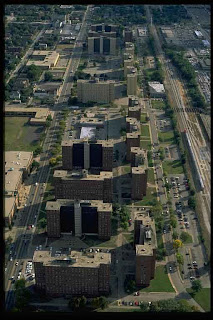 One of the things that got lost in the last week is the anniversary of the death of Swiss architect Le Corbusier.
One of the things that got lost in the last week is the anniversary of the death of Swiss architect Le Corbusier.I had intended to write about his legacy on August 27, 45 years after he died. His ideas about building new cities with apartment towers had repercussions around the world.
The idea, of course, was to make things better for people. Getting rid of substandard, unhealthy housing, and separating industry from residential areas was supposed to reform both cities and the people who lived in them. Nine decades after he began to expound his ideas, it is clear that the "tower in the park" he advocated has been a failure nearly everywhere except under special conditions.
Apartment towers for rich or upper middle class people seem to work reasonably well, but where corners were cut in construction and the poor were isolated in them, urban disaster has been nearly universal. Many such projects in the US--the picture on the left is of the Robert Taylor Houses in Chicago which have almost all been torn down--lasted only a few decades before they were demolished.
The picture on the right was taken in 2005 in Shanghai, which then was razing low rise traditional housing in order to build towers. The jury is still out on how well they will succeed, but recent rumbles of dissatisfaction have been heard as far away as North America.

The photo at bottom is of Singapore, which is probably the one successful, large scale exception. There people were able (or strongly encouraged, or maybe even coerced, depending on your point of view) into buying apartments in buildings where care was taken to mix income and ethnic groups. Good public transit and nearby jobs were also part of the planning.
The fact that I've seen no other mention of Le Corbusier's legacy in the last week is a measure, I think, of the just disrepute his ideas have fallen into.
Moral: bad ideas are sometimes dangerously popular. Better not to destroy but add to what is already working, as Jane Jacobs advised.


















No comments:
Post a Comment